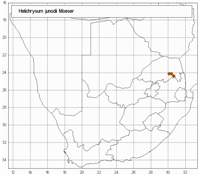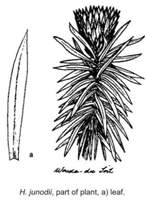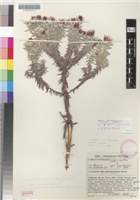Origin of name:
junodii is named after Henri-Alexandra Junod (1863�1934) a Swiss missionary who collected plants at various localities in South Africa and Lesotho.
Diagnostic characters:
Large solitary headsGrey hairy linear leavesMaroon bractsWoody plant
Description:
Stoutly branched low-growing shrub, ultimate branchlets thinly white-woolly, closely leafy throughout. Leaves spreading, later reflexed, 12�22 x 1�3 mm, linear or linear-lanceolate, acute, apiculate, base slightly narrowed, half-clasping, margins more or less revolute, upper surface glandular-puberulous, thinly greyish-white cobwebby as well, lower thickly white-woolly. Heads heterogamous, campanulate, c. 15 mm long, double that across the radiating bracts, solitary at branchlet tips. Involucral bracts in c. 10 series, graded, imbricate, inner much exceeding flowers, outer series rich glossy rose pink, outermost with a brown overcast, inner white, acuminate. Receptacle shortly honeycombed. Flowers c. 350�460, 30�50 female, 325�425 homogamous. Achenes not seen, ovaries glabrous. Pappus bristles many, equaling corolla, barbellate above, bases not cohering.
Flowering between April and July.
Distribution:
Recorded only from the mountains between the Wolkberg and The Downs, Limpopo Province, among rock, outcrops in grassland.
Grassland and Savanna Biomes.
Notes:
A most handsome plant with silvery leaves and rose pink and white heads. Has been confused with H. reflexum, but easily distinguished by its bigger softer leaves and bigger heads.Taxonomy:
Literature:
Helichrysum junodii Moeser in Bot. Jb. 44: 334 (1910).
Type:
Mpumalanga, Shilouvane, Junod 934 (G).
Synonym(s):
Vouchers:
M�ller & Scheepers141 (PRE); Rogers 20107 (J; PRE; Z).

